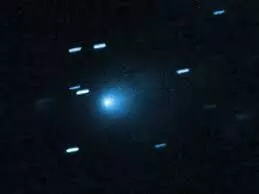3I/ATLAS: Interstellar Object’s Mysterious Nickel Detection Sparks Debate, NASA’s Silence Raises Questions
Interstellar object 3I/ATLAS shows mysterious nickel emissions without iron, raising questions about its origin. NASA remains silent as Harvard’s Avi Loeb hints at possible artificial origin.
3I/ATLAS Interstellar Object: Nickel Detection Baffles Scientists, Harvard Expert Warns of “Black Swan” Event

The newly discovered interstellar object 3I/ATLAS has baffled astronomers worldwide after nickel vapor was detected in its emissions — a finding scientists describe as “highly unusual” and chemically inexplicable under known cosmic conditions. The discovery has sparked debates about its origin, composition, and NASA’s silence on the matter.
Discovery and NASA’s Quiet Response
Detected in July 2025 by the Asteroid Terrestrial-impact Last Alert System (ATLAS), 3I/ATLAS is the third confirmed interstellar object after ‘Oumuamua (2017) and 2I/Borisov (2019). Roughly the size of Manhattan, the object entered the solar system on a hyperbolic trajectory, confirming its interstellar origin.
While NASA has refrained from issuing detailed public statements, it is closely monitoring the object through the International Asteroid Warning Network (IAWN). According to reports, NASA’s planetary defense systems were quietly activated when the object began showing unexpected acceleration and developed an anti-tail pointing toward the Sun — an anomaly unseen in typical comets.
Unusual Chemical Findings
Observations from Chile’s Very Large Telescope (VLT) stunned scientists when they revealed nickel vapor — a metal that cannot normally vaporize at such cold, distant regions of space. Even more puzzling was the absence of iron, which typically accompanies nickel in cosmic material.
Further analysis detected nickel tetracarbonyl, a compound found only in industrial chemical processes on Earth, intensifying speculation about a non-natural origin. Meanwhile, data from the James Webb Space Telescope (JWST) confirmed abnormally high carbon dioxide levels and minimal water vapor — unlike any known cometary composition.
Harvard Astrophysicist’s Warning
Renowned Harvard scientist Avi Loeb described 3I/ATLAS as a potential “black swan event” — a rare cosmic occurrence that could challenge current astrophysical models.
Loeb suggested that 3I/ATLAS’s massive structure (estimated at 33 billion tons) and unexplained motion might indicate artificial origin, possibly an alien probe. “Its acceleration cannot be explained purely by gravitational forces,” Loeb noted, comparing it to a “Trojan horse” that may appear natural but hides advanced technology.
Anomalies and Orbit
Images from Hubble and other observatories show a faint gas coma forming unusually early, with a tail directed toward the Sun, defying normal comet behavior. Spectroscopic data indicate the object formed in an extremely cold, alien environment, hinting it originated outside the Milky Way’s inner regions billions of years ago.
3I/ATLAS will make its closest approach to the Sun on October 29, 2025, coming no nearer than 268 million kilometers from Earth — posing no danger to the planet. However, its behavior may evolve as it nears perihelion, and NASA plans intensive monitoring through early 2026.
Why It Matters
The study of 3I/ATLAS could rewrite what scientists know about interstellar chemistry. Its nickel-without-iron signature and abnormal orbit contradict established models of comet formation.
Researchers are comparing it with ‘Oumuamua and 2I/Borisov to determine whether building materials in distant star systems follow universal rules or vary across the galaxy. The findings could reshape our understanding of planetary formation and interstellar matter.
Ongoing Research
Teams from Chile, Italy, Canada, the U.K., the U.S., and New Zealand continue coordinated studies via JWST and the VLT. Scientists aim to uncover whether the nickel compounds result from low-temperature chemical reactions or something truly unprecedented — perhaps artificial.
As 3I/ATLAS departs the solar system in 2026, it may carry with it vital clues about alien environments — and possibly, about life beyond Earth.

